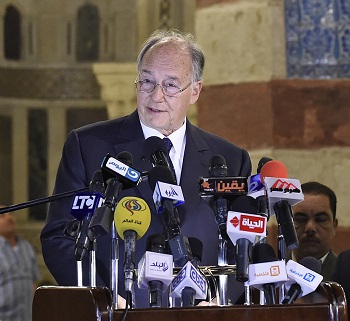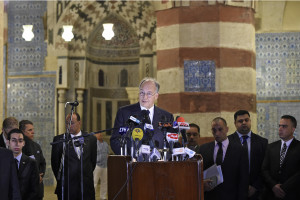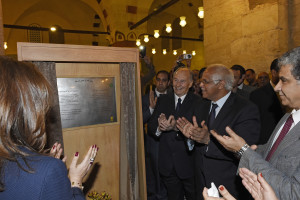 Speech by His Highness the Aga Khan — Inauguration of Amir AqSunqur Mosque in Cairo
Speech by His Highness the Aga Khan — Inauguration of Amir AqSunqur Mosque in Cairo
Please watch videos below also, thanks – the Editor
May 2, 2015
Bismillah-ir-Rahman-ir-Rahim
Your Excellency the Minister of Antiquities,
Your Excellency, the Governor of Cairo,
Your Excellencies, Honourable Ministers,
Your Excellencies,
Distinguished guests,
Ladies and gentlemen,
It is an immense pleasure to join all of you once again, in this special celebration. The inauguration of the AqSunqur Mosque is an extraordinary moment in its own right. And it also marks the culmination of a larger revitalisation that has taken place over many years in historic Cairo.
As Muslims, we are invited to protect and enhance the world in which we live during our lifetimes. We are trustees of God’s creation, hence the word Trust in the name of the agency responsible for this restoration.
I remember well when the seeds for our cultural engagement in Cairo were first planted at a seminar more than thirty years ago.
You may know about the enormous dumping ground of debris that had developed over the centuries, and surrounded one of Cairo’s poorest neighbourhoods. And you will also know of our effort to create a state-of-the-art green space, the Azhar Park — and how that effort soon extended into a great archaeological adventure, uncovering and restoring some of Cairo’s oldest buildings.
The 12th century Ayyubid wall, for example, was almost completely covered in debris. We could not even tell how long it was! Today, thanks to the work on site, important remains of the Fatimid and Mamluke walls have been discovered and preserved. The minarets of the Khayrbek and Umm al Sultan Shabaan, like other landmark structures, were badly compromised. Six centuries of wear and tear had taken a toll — one that was difficult to reverse, especially given the vast array of heritage sites in Egypt that were competing for scarce resources.
Nonetheless, with the approach of a new century, the work of restoration began here in the Darb al Ahmar neighborhood. And today, thanks to so many of you, we celebrate another important milestone in that stirring story.
That story has featured a great many partnerships – with the Egyptian government, the Governorate of Cairo, the Supreme Council of Antiquities, the World Monuments Fund, the Social Fund for Development, the Swiss Egyptian Development Fund, the Ford Foundation, and the French Institute of Archaeology and the people of Darb al Ahmar. It has truly been a “team” effort – joining a host of local, national and international players.
The restoration of the Aq Sunqur Mosque was itself executed by a team of 60 to 80 craftsmen and conservators. They had first to remove the temporary supports installed after the 1992 earthquake – and then to implant seismic retrofit measures to protect against future earthquakes. They worked to conserve extensive roofing and facades on the one hand, and delicate marble panels and Iznik ceramic tiles on the other. And if you look at the global map you will see that the Ummah often lives in seismic areas.
But it is not enough only to conserve an architectural treasure. Restoration projects can also serve as springboards — as trampolines — for broad social and economic development and poverty reduction. In that process, they can help create both the human constituency needed to sustain a project — and the flow of funding needed to maintain it.
The Aga Khan Trust for Culture strives to approach such opportunities through a multi-tier, multi-dimensional strategy, drawing on experts not only from fields such as archaeology, conservation, restoration, and engineering, but also from the worlds of finance, tourism, education, sanitation and public health — among others. The cultural components of such projects are numerous, varied, and much less finite than most other development initiatives. The Trust therefore remains engaged with its projects, as will be the case here in Egypt, for long periods.
The result of pooling a wide array of talents is that we can also talk about a wide array of accomplishments. We can begin, of course, by saying that seven major monuments were restored here in Darb-al-Ahmar, and that three public open spaces were created. We can take pride in the 17 million visitors that have already come to the Azhar Park. We can talk about how one thousand people were employed directly in this work, while another sixteen hundred were assisted in finding other long-term jobs. We can talk of 175 craftsmen who were trained in restoration skills, while another two thousand people finished other forms of technical and vocational training.
The overall impact on the quality of life in this community has been palpable. Disposable family income in Darb al-Ahmar, for example, increased by 27% between 2003 and 2009 – one third faster that in the whole of Old Cairo. Literacy rates climbed by one-fourth. And the impact will continue to ripple out beyond this community. For example, hundreds of young Egyptians have been trained in restoration by some of the world’s best experts; and they have gone on to create autonomous teams which can take on restoration projects anywhere in Egypt.
Let me also underscore another central motivation for this work. Through revitalisation of the sort we celebrate today, we hope to preserve an extraordinary panorama of Islamic history, from the Fatimid Caliphs to the present. At a time when fractures in the unity of the Ummah are so highly visible, I see such projects as particularly hopeful. They are important symbols for the identity of all Muslims, sources of pride for the entire Ummah.
And finally I would like you to know that a young Muslim walking here in the 22nd century will be able to feel the pull of his or her own history, even in a radically transformed world.
And let us be reminded, too, that in undertaking this work, we are not only attending to our own Islamic heritage, but also preserving an essential part of the patrimony of all humankind.
I can say to you today that the potential power of Islamic cultures is such that the Ummah is capable of achieving global recognition for its amazing heritage of unique spaces and buildings.
Thank you.
Source: AKDN – Press Release in Arabic
Fatimid Imam Caliphs built Cairo — Video
The Surah Noor mentioned in the above video is as follows:
Allah is the light of the heavens and the earth;His light is as a niche in which is a lamp, and the lamp is in a glass, the glass is as though it were a glittering star; it is lit from a blessed tree, an Olive neither of east nor of the west, the oil of which would well-nigh give light though no fire touched it, – light upon light – Allah guides to His light whom He pleases; and Allah strikes out parables for men; and Allah all things doth know.
– Quran Chapter Light 24:35
Read more here by the Aga Khan III on Spirituality
Aga Khan Restores AkSunkur Mosque Cairo – Amaana.org


The Fatimid Caliphate (Arabic: الفاطميون, al-Fāṭimiyyūn) was a Shia Islamic caliphate, which spanned a large area of North Africa, from the Red Sea in the east to the Atlantic Ocean in the west. The dynasty ruled across the Mediterranean coast of Africa and ultimately made Egypt the centre of the caliphate. At its height, the caliphate included in addition to Egypt varying areas of the Maghreb, Sudan, Sicily, the Levant, and Hijaz.
The Fatimids were descended from Fatima bint Muhammad (Arabic: فاطمة بنت محمد), the daughter of the Islamic prophet Muhammad, according to Fatimid claims. The Fatimids conquered North Africa and their Fatimid state took shape among the Kutama, in the Western North of Africa, particularly Algeria. In 909 Fatimid established the Tunisian city of Mahdia as their capital. In 948 they shifted their capital to Al-Mansuriya. In 969 they conquered Egypt and established Cairo as the capital of their caliphate, and Egypt became the political, cultural, and religious centre of the whole state.
This video is targeted to blind users.
Attribution: Article text available under CC-BY-SA
Fatimid History Video
Watch this Fatimid Architecture video while above audio is playing!
The Fatimid Caliphate or al-Fātimiyyūn (Arabic الفاطميون) was an Arab Shi’a dynasty that ruled over varying areas of the Maghreb, Egypt, Sicily and the Levant from 5 January 909 to 1171. It was the fourth and final Arab caliphate. The caliphate was ruled by the Fatimids, who established the Egyptian city of Cairo as their capital. The term Fatimite is sometimes used to refer to the citizens of this caliphate. The ruling elite of the state belonged to the Ismaili branch of Shi’ism. The leaders of the dynasty were also Shia Ismaili Imams, hence, they had a religious significance to Ismaili Muslims. They are also part of the chain of holders of the office of Caliph, as recognized by most Muslims, the only period in which the Shia Imamate and the Caliphate were united to any degree, excepting the Caliphate of Ali himself.
With exceptions, the Fatimids were reputed to exercise a degree of religious tolerance towards non-Shi’a sects of Islam as well as towards Jews, Maltese Christians and Coptic Christians.
Divinal abdulsacoor….www.imo.abdulsacoor.com portugal